January 2024
Monthly Archive
Wed 31 Jan 2024
A 1001 MIDNIGHTS Review
by Bill Crider
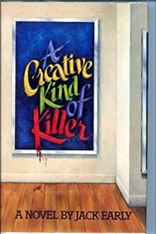
JACK EARLY – A Creative Kind of Killer. Fortune Fanelli #1. Franklin Watts, hardcover, 1984. Carroll & Graf, paperback, 1995, as by Sandra Scoppettone (the author’s real name).
Fortune Fanelli, the first-person narrator of A Creative Kind of Killer, is a former cop who inherited money, made a lucky investment, and left the force. He’s now a private investigator, but not exactly the usual kind. He’s a single parent, trying to bring up his two teenage children and work on murder cases at the same time.
His ex-wife, a soap-opera producer, has no real interest in raising children, so Fortune gets the job. He lives in New York’s SoHo district, and the first murder in the book takes place right in his neighborhood. The killer is “creative,” posing the corpse in the window of a boutique so artfully that Fanelli himself admits he must have passed the body six limes without noticing it.
His investigation of the case leads him both into the arty crowd and into the more sordid world of runaways and kiddy porn.
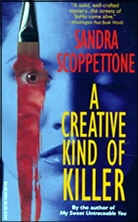
A Creative Kind of Killer is a promising debut. Fanelli is an interesting character, and his relationship with his children makes for a different kind of subplot. The love interest is provided by a young woman who is a dead ringer for Meryl Streep; and Father Paul, the handsome local priest. is a strong character.
Early is particularly good in his descriptions of SoHo, and Fanelli’s feelings about the changes in his old neighborhood are an effective commentary on one man’s desire to remain involved in his community. The mystery is a good one, too, and the resolution satisfactory. It seems likely that Fanelli will appear in other cases in the near future.
Early’s second novel, Razzamatazz (1985), is a straight thriller sans Fanelli, however.
———
Reprinted with permission from 1001 Midnights, edited by Bill Pronzini & Marcia Muller and published by The Battered Silicon Dispatch Box, 2007. Copyright © 1986, 2007 by the Pronzini-Muller Family Trust.
[UPDATE]: In spite of Bill’s suggestion that it might happen, a second recorded case for Fortune Fanelli never occurred.
[ADDED NOTE]: This is the first of four reviews that went missing during the loss of service undergone by this blog over this past weekend. Unfortunately all of the comments for it have permanently disappeared.
Wed 31 Jan 2024
Posted by Steve under
General[10] Comments
I say that with my fingers crossed, since I haven’t tested everything, but with only a few casualties, the recent outage crisis for the blog is over. What had to be done was a full restore to the blog going back to before the problem arose. That seems to have done the trick.
Missing, though, are all of the posts that appeared here after Tuesday of last week. I made backups of those, though, and they will all appear again as soon as I can get to them. The bad news is that any comments that were left for those most recent posts are gone forever.
This is better news than I was anticipating, though, as one possible outcome for the restore operation was that the posts would all come back, but ALL of the comments left for the blog since its inception would have disappeared. That would have been a loss awfully hard to take.
So that’s the news for now. I’ll get to work replacing the missing posts as soon as I can.
Sun 21 Jan 2024
Posted by Steve under
Reviews[2] Comments
REVIEWED BY BARRY GARDNER:
ED McBAIN – Gladly the Cross-Eyed Bear. Matthew Hope #12. Warner, hardcover, 1996; paperback, 1998.
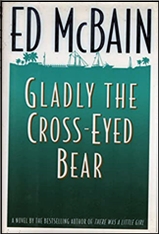
The [previous] Hope novel, There Was a Little Girl, ended on something of an uncertain note, and I was interested to see where and if McBain would go from there with the series. Though one of the [earlier] books — Mary, Mary — was just about as bad as they come, on the whole I’ve enjoyed [them]. Neat title on this one, too.
Gladly, the optically-challenged ursine, is a toy invented and patented by Hope’s young lady client. The problem is that her previous employers, a toy designing and making firm, are marketing a very similar toy. She’s suing, and they’re counter-suing, and who knows what the judge will decide?
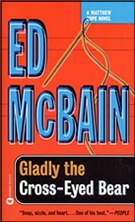
That all fades into the background when one of the legal antagonists gets messily murdered, and Hope’s client is charged with the crime. Did Hope, recently emerged from a five-month coma, doesn’t think so, but proving it is another story. Particularly so because the story his client tells keeps changing, and never for the better.
McBain nearly always writes like the seasoned, best-selling professional he is, and that’s the case here. There is a dab of courtroom (all connected with the patent case), some investigation, a tad of Hope’s personal problems, a little danger, and it’s all mixed into a very readable and enjoyable book.
Taken separately, none of the elements are anything special, and in the hands of a less accomplished writer, it would have been an average read at best; but McBain is McBain, and that do make a difference.
— Reprinted from Ah Sweet Mysteries #26, July 1996.
Fri 19 Jan 2024
Posted by Steve under
Reviews[4] Comments
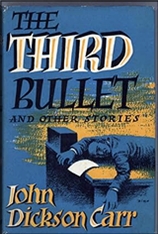
JOHN DICKSON CARR. “The Third Bullet.” Colonel Marquis #1. Novella. First published as a novel in 1937 under Carr’s “Carter Dickson” pen name (Hodder & Stoughton, UK). A shorter version appeared in Ellery Queen’s Mystery Magazine, January 1948 (cut by perhaps 20%). Collected in The Third Bullet and Other Stories (Hamish Hamilton, UK, hardcover, 1954; Harper & Bros., US, hardcover, 1954). Collected in Locked Room Puzzles, edited by Martin H. Greenberg & Bill Pronzini (Academy Chicago, paperback, 1986).
This one is a good one, but only if you’re already a fan of locked room mysteries. If you’re not, I don’t think it will go down well enough to convert you. It’s too single-minded as to the plot, with the barest amount of time spent of either the setting or the characters. But for the record, here’s the basic setup and hold on tight. It’s complicated:
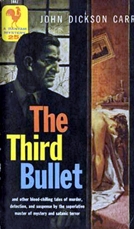
A murder is committed while the police are watching from the outside through a window and while another policeman is knocking on the only inside door leading to a hall inside the house. The windows are sealed tight (but footsteps are found leading from one of the windows). Only one person was in the room, other than the victim. No one else went in nor went out. No one was hiding inside.
Two guns are found in the room. One was the one the suspect used; the other is found hidden in a vase. However — and this is a big “however” — ballistics show that neither one was used to kill the victim, a judge who had previously sentenced the suspect quite severely (flogging as well as a prison term).
The investigation begins on page one, and it continues non-stop until the case is solved. Colonel Marquis is clearly a forerunner of Colonel March, one of Carr’s other more well-known detectives. Even if this was his only appearance, which is likely, he’s the sort of fellow who relishes a case such as this one, and almost as much as I do. The basic explanation is both very intricate and very simple, but the latter doesn’t mean I solved it before Colonel Marquis does.
To my mind, very nicely done.
Wed 17 Jan 2024
Posted by Steve under
Reviews[2] Comments
Reviewed by TONY BAER:
MICHAEL Z. LEWIN – The Way We Die Now. Albert Samson #2. Putnam, hardcover, 1973. Perennial Library, paperback, 1984. Mysterious Press, paperback, 1991.
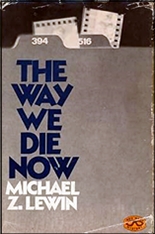
Albert Sampson, PI. A bit nebbish. Late 30s. Sleeps in his office in Indianapolis. Barely making it.
A mother calls on behalf of her daughter. A whiny, overbearing one at that. And looking for the cheapest sleuth in town. They found him.
Daughter’s husband Ralph just killed a guy. He’s in jail, facing manslaughter charges.
What happened is this: Ralph was as a security guard with Easby Guards. The company requires their employees to carry double barreled shotguns. It’s an image thing, really. But they are loaded for bear.
Ralph’s a Vietnam vet that got discharged after he lost his gourd in battle. He can’t find work and the only work he’s not willing to do is anything involving a gun. So of course this security job is perfect! Well, what happens is that Easby Guards has been seeking out PTSD discharged vets to hire. They’e framing it as philanthropy. But is there something more sinister happening?
Ralph is convinced to give the job a try. But the first night on the job, one of the tenants in the building Ralph’s assigned to tells him he’s scared a guy is gonna try to kill him tonight. Please protect me he pleads.
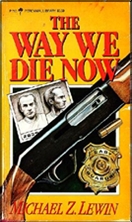
Later that eve, a menacing looking man knocks on the tenant’s door. The tenant opens it, screams to shoot when the man reaches for something under his coat. And Ralph does. His aim is true. The man dies, instantly.
The cops show. And the tenant says: I don’t know what happened. Ralph just went crazy and shot this guy for no reason. I never told Ralph to shoot. I never told Ralph I was scared of the guy, or that I’d been threatened.
Given Ralph’s psychiatric history, the cops figure the tenant’s story is probably right: Ralph just went bananas, shooting the stranger for no reason. Just like he did in Vietnam. Manslaughter.
Sampson takes the case on. But you wonder why. According to Ralph’s lawyer, it’s manslaughter now, and it’s still manslaughter if he proves he was told to kill the guy. So why bother?
The REAL reason should be this: ‘Defense of others’ is a defense to liability for an alleged crime that is in defense of a person other than oneself. It refers to a person’s right to use reasonable force to protect a third party from another person who threatens to use force on the third party. [See, for example, https://www.law.cornell.edu/wex/defense_of_others.]
Unfortunately, this doesn’t occur to Ralph’s lawyer or to Samson. What pisses me off a bit is when I’m a better lawyer that the lawyer in the book.
—
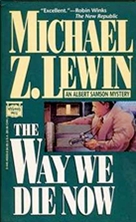
The book was okay. I like Albert Samson. And that itself is something. It’s tricky trying to write a contemporary detective novel while avoiding pastiche. Although we are precisely at this moment as far from this Samson novel as this Samson novel was from the Continental OP (50 years, to be exact). There is in fact some similarity between Albert Samson, Jacob Asch, David Brandstetter, Harry Moseby from Night Moves, Moses Wine, Harry Stoner, Jim Rockford, Travis McGee, Lebowski, Doc Sportello, John Marshall Tanner, and Elliott Gould’s Philip Marlowe.
Such that it may be fair to say that there’s a second archetypal detective. There’s the Philip Marlowe/Sam Spade classic PI’s of the 30s and 40s. Smoke and whiskey. Black and white. Knights errant in a world gone noir. And then there’s the laconic seventies dude detectives. As likely to be smoking a joint as drinking a beer. Wasting away again in Margaritaville.
The problem with the book is that, like its detective, it lacks ambition. There’s a heavy book inside it with some weighty stuff to explore and possible vindication of his client. Yet Samson settles for mediocrity. Like Lebowski says, forget it dude. Let’s go bowling.
Tue 16 Jan 2024
Posted by Steve under
Reviews[5] Comments
HARRY WHITTINGTON – Married to Murder. Joel Palmer #1 (and done). Phantom #503, digest-sized paperback original, 1953. Berkley Diamond D2019, paperback, September 1959. Gryphon Books, softcover, 2005.
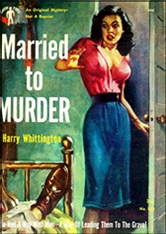
From the early 1950s and clear into 1970s, Harry Whittington was one of the most prolific paperback writers around, publishing nearly 200 novels under a host of pen names. What he’s best known for by connoisseurs of such things was a unique combination of noir/hardboiled/sleaze fiction. For all that work, I don’t believe he produced another private eye novel other than this one. (I could easily be wrong about that.)
Joel Palmer, the protagonist in this one, was once a cop but he’d been forced to resign, and when Married to Murder begins, he’s trying to eke out a living as a PI and not doing a very good job of it. Worse, the police are continually hounding him, with obvious malicious intent. So when a old woman with one leg and a crutch to help her get around comes looking for him, he takes her up on the offer she makes, as dubious and offputting as it sounds.
He’s to move in with the woman’s granddaughter, under the pretense of being her husband. His first reaction is a natural one. He laughs. But the granddaughter, who thinks her husband is dead, is in deadly danger, he is told, although exactly why, she refuses to say. At length, confronted with threats of calling his personal nemesis on the police force, he agrees.
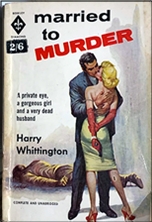
Some plastic surgery is involved. That’s a given. But to make the change permanent, he has to agree to put his identification papers on the person currently being stored in a small freezer and dump the body in the East River. After this point in time, Joel Palmer will be dead. Assisting him on this task is the old woman’s maid, a strange enigmatic creature who dresses in tight-fitting black dresses. (Use your imagination here.)
While two of them are on this midnight disposal run, our hero (of sorts) discovers that the man, whom he has been told died of natural causes, was really a victim of cold-blooded murder. By this time, though, it is far too late for him to turn back.
Which all of the above takes up the first 64 pages of a mere 144 page novel, but between you and me, these are 64 pages I will never forget. Once he hits Florida, where the granddaughter lives, and the impersonation begins, the book settles down into a more conventional sort of tale, but conventional in the hands of a writer such as a Harry Whittington was in that regards is still heads and shoulders above almost any other PI writer I can think of.
It’s not a classic, mind you. There are way too many implausibilities built into the plot as it unfolds to say that. I didn’t believe them all myself, even while I was reading it. Safe to say, you’d be better off just fastening your seat belt and going along for the ride.
H/B rating: 8.9
Tue 16 Jan 2024
Posted by Steve under
Reviews[2] Comments
REVIEWED BY DAN STUMPF:
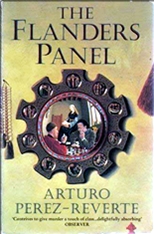
ARTURO PEREZ-REVERTE – The Flanders Panel. Harcourt Brace, hardcover, 1994. Reprint editions include: Bantam, paperback, 1996. Vintage Books, softcover, 2003. Harvest Books, softcover, 2004.
I was looking forward to great things from The Flanders Panel by Arturo Perez-Reverte but — alas! — found myself bitterly disappointed at a book filled with cardboard characters, a painfully obvious “surprise” killer, and endless pages of talky explication for a climax.
These shortcomings (and many others) stand out all too sharply against a plot of striking intelligence; Julia, a beautiful young art expert, is commissioned to restore a renaissance-era painting of a Duke and Knight playing chess while the Duchess looks on in the background (Perez-Reverte describes this painting so vividly the reader can almost see it in brilliant color and sharp focus) but stops abruptly when x-rays reveal a message hidden under a layer of paint: “Who killed the Knight?”

For the answer, she recruits a small band of friends and friends-of-friends (all, alas, as two-dimensional as Julia herself) to reconstruct the game on the painting and discover who took the Knight by playing it backwards. Which works fine until her friends themselves start getting killed by someone who leaves little notes with chess moves on them.
It’s a dandy idea for a mystery, and I only wish Perez-Reverte had given it a worthy execution. As it was, I saw the Killer come marching down Main Street with a big brass band, but for some reason the author thought he needed twenty-odd pages of “… then I did … but you never suspected I …” to put it across.
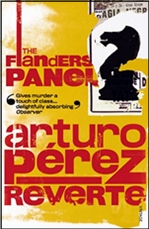
Equally bad is his tendency to imply something very very clearly, then go ahead and state the obvious in case we missed it. So we get a couple paragraphs where Julia’s older-woman, sexually predatory (and two-dimensional) employer looks with a proprietary air at young man, extols his sexual prowess, then Perez-Reverte adds, “He was the latest in her long line of lovers.”
Or several lines describing Julia’s ex-lover/former teacher, a cliche’d College Professor who wears tweed jackets with patched elbows, knit ties, and sandy hair graying at the temples, and Perez-Reverte caps his description by saying that “he looked like a stereotype of a professor.” Well du-uh.
Reading this is like sitting at a great feast of words and being tossed the scraps; it insults my intelligence, and I’d take Perez-Reverte to account for it, if I weren’t afraid of him. As it is, I’m going to give him another try, this time with lowered expectations.
— Reprinted from The Hound of Dr. Johnson #7, May 2000.
Mon 15 Jan 2024
MANNING COLES -The House at Pluck’s Gutter. Tommy Hambledon #26 (including one collection of short stories). Pyramid X-1782; paperback, first US edition, April 1968. Published earlier in the UK by Hodder and Stoughton, hardcover, 1963.
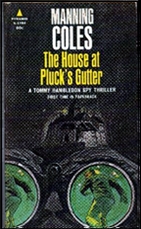
A pair of binoculars with a concealed piece of microfilm leads Tommy Hambledon and his amateur assistants on a chase from Belgium to Rome and finally back to England. Forgan and Campbell are given brief tours of [every] prison along the way, and Hambleldon himself is arrested at least twice, endures several blows on the head, is thrown overboard in a sack, and then trapped at the top of a radio tower.
The microfilm ends up in the hands of the diplomatically immune Knights of the Reconciliation, who plan to blackmail England for its return.
The humor [of Hambledon’s previous escapades this time] affords only an occasional smile — too close to slapstick? — but the ending, with a film company’s version of the Marines to the rescue, was lunatic genius. In fact, the concluding chapters were much easier to take than all of the initial running around. The author’s use of punctuation was bewildering at times, with lots of exclamation points, but that’s a minor quibble.
Rating: ***½.
— June 1968.
Update: Until the former’s death, hidden behind the Manning Coles byline was a long-running collaboration between two British writers, Adelaide Frances Oke Manning (1891 – 1959) and Cyril Henry Coles (1899 – 1965).
The last two Hambledon books, including this one as the last, were written by Coles and Tom Hammerton. Why this one first appeared only as a paperback original in this country is a mystery.
Sun 14 Jan 2024
Posted by Steve under
Reviews[5] Comments
REVIEWED BY BARRY GARDNER:
JAMES CRUMLEY – Bordersnakes. C. W. Sughrue & Milo Milodragovitch #3 (each, not together). Dennis McMillan, hardcover, limited edition, 1996. Mysterious Press, hardcover, 1996. Warner, paperback, 1997. Vintage Crime/Black Lizard, softcover, 2016.
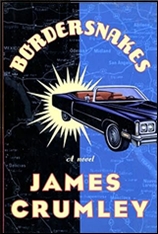
The man by whose largess I read this thought this was top-notch stuff. This heartened me less than you might think, because he also liked The Mexican Tree Duck, which I thought was about as thoroughgoing a piece of garbage as I read that whole year. But excelsior …
Milodragovitch has come into his middle-age inheritance — just in time to find that a crooked banker has relieved him of most of it. He’s in a frame of mind for revenge and recovery, and heads to Texas to find his old drinking, doping, and PI buddy C. W. Sughrue to help him.
He finds C. W., all right; scarred, married, and hiding out from people who wanted to kill him and almost did. Together they set out on an odyssey across Texas, hunting for the banker and maybe themselves. They find whiskey, dope, and danger everywhere they tum, and there are more turns than they looked for.
The thing that still bothers me about Crumley’ s books is that the people he writes about are adolescent fantasies of the kind of people it would be cool to be: hard-fighting, hard-doping, romantic idiots who are moved only by their addictions. And that Crumley himself seems to admire this, and to think it’s the way a man should be.
Another reason [to be bothered] is that the plot is a maze of wild, unlikely coincidences; plot never was Crumley’s thing. Balanced against all that, and in the end overcoming it, is the fact that the son of a bitch can write. He can tell you a story well enough to drag you along over the rough spots so fast and enjoyably that you barely feel them until later, much like the bruises from an athletic contest. And while the things his people do may not make much sense at times, the people themselves are real while he’s writing about them, and you find yourself cheering their antics as mindlessly as they perform them.
— Reprinted from Ah Sweet Mysteries #26, July 1996.
Fri 12 Jan 2024
Posted by Steve under
Reviews[5] Comments
Reviewed by TONY BAER:
OCTAVUS ROY COHEN – Midnight. Dodd Mead & Co., hardcover, 1922.
Spike Walters drives a cab. He’s waiting on a train. It’s midnight. A frigid winter.
A woman comes out, fancy in a fur coat, hails him thru the hail.
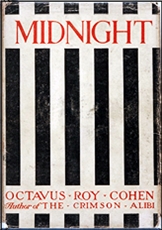
She gives him an address way out in the boonies. But when he gets to the address, she’s gone and a dead man is lying in her place. Shot thru the heart. A bursted vein. She gives love a bad name.
Spike calls the cops. It is laid upon Detective David Carroll to solve the crime.
Carroll calls himself a “psychological” detective. But he’s not, really. He’s just a really good conversationalist. He inspires trust, and people talk to him.
The story proceeds as a pleasant procedural, as Carroll interviews and re-interviews various suspects. Nary a sign of the “scientific methods” of other detectives. Carroll says he doesn’t care what people say to him. He just wants them to speak freely so he can watch them as they speak. The way folks tell their stories, a lie may contain as much as the truth.
Carroll is very likeable, and convinces the Chief of Police to hold off on any 3rd degree methods. So no rough stuff. Just soft shoe conversation with upper crust suspects until they crack as the accumulation of facts and the natural contradictions of false alibis crumble under their own weight.
Speaking of weight, this thing is so light it could fly away with a soft wind. But it’s a pleasant way to fritter the time away.
Previously reviewed here: https://mysteryfile.com/blog/?p=958
Next Page »
















